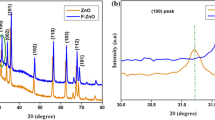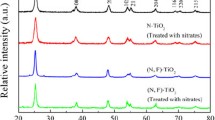Abstract
N/F-doped NaTaO3 powders were synthesized via a hydrothermal method at 160 °C. The influences of N/F co-doping on the crystal structure, morphology and photocatalytic properties of the NaTaO3 powders were investigated systematically. Rietveld refinement of X-ray diffraction data confirm that the nanoparticles of pure NaTaO3 have orthorhombic structures with Pc21n:bca and Ta2O5 can be obtained by doping N/F molar ratio (NaOH/NH4F ≤ 1) with the orthorhombic P2 mm:cab space group. The NaTaO3 powders are transformed from orthorhombic Pc21n:bca into monoclinic P2/m:b space group with the NaOH/NH4F molar ratio (NaOH/NH4F > 1). The well-defined cubic block NaTaO3 single-crystalline particles with the size of 0.5 μm are determined using TEM and grow preferentially along (101) and (010) crystal planes. The photocatalytic activities were evaluated by the degradation of Rhodamine B under UV-light irradiation. The possible mechanism is proposed to discuss the enhanced photocatalytic activity based on the increasing separation efficiency of photoinduced charge. The results illustrate that the obtained monoclinic N/F-NaTaO3 (NaOH/NH4F = 1.5/1.0) powder exhibits the best photocatalytic activity with the UV-light irradiation for 210 min.









Similar content being viewed by others
References
A. Fujishima, K. Honda, Electrochemical photolysis of water at a semiconductor electrode. Nature 7, 238 (1972)
J. Senthilnathan, L. Philip, Photocatalytic degradation of lindane under UV and visible light using N-doped TiO2. Chem. Eng. J. 161, 83–92 (2010)
A. Kudo, Y. Miseki, Heterogeneous photocatalyst materials for water splitting. Chem. Soc. Rev. 38, 253–278 (2009)
O. Vázquez-Cuchillo, A. Cruz-López, L.M. Bautista-Carrillo, A. Bautista Hernández, L.M. Torres-Martínez, S.W. Lee, Synthesis of TiO2 using different hydrolysis catalysts and doped with Zn for efficient degradation of aqueous phase pollutants under UV light. Res. Chem. Intermed. 36, 103 (2010)
S. Lee, I.S. Cho, D.K. Lee, D.W. Kim, C.H. Kwak, S. Park, K.S. Hong, J.K. Lee, H.S. Jung, Influence of nitrogen chemical state on photocatalytic activities of nitrogen-doped TiO2 nanoparticles under visible light. J. Photochem. Photobiol. A 213, 129–135 (2010)
R. Leary, A. Westwood, Carbonaceous nanomaterials for the enhancement of TiO2 photocatalysis. Carbon 49–3, 741–772 (2011)
B. Zielinska, A.W. Morawski, TiO2 photocatalysts promoted by alkali metals. Appl. Catal B Environ. 55, 221–226 (2005)
S. Onsuratoom, S.C. Vadej, T. Sreethawong, Hydrogen production from water under UV light irradiation over Ag-loaded mesoporo assembled TiO2–ZrO2 mixed oxide nanocrystals photocatalysts. Int. J. Hydrogen Energy 36, 5246–5261 (2011)
Y. Wang, C. Feng, M. Zhang, J. Yang, Z. Zhang, Enhanced visible light photocatalytic activity of N-doped TiO2 in relation to single-electron-trapped oxygen vacancy and doped-nitrogen. Appl. Catal. B 100, 84–90 (2010)
G. Xiuquan, B. Wang, Q. Zhang, Y. Zhao, Y. Qiang, Preparation of ultrathin TiO2 single-crystal nanowires for high performance dye sensitized solar cells. J. Mater. Sci. Mater. Electron. 24, 520–523 (2013)
M. Dang, Y. Zhou, H. Li, C. Lv, Preparation and photocatalytic activity of N-doped TiO2 nanotube array films. J. Mater. Sci. Mater. Electron. 23, 320–324 (2012)
S. Kumar, B. Kumar, g-C3N4/NaTaO3 organic–inorganic hybrid nanocomposite: high-performance and recyclable visible light driven photocatalyst. Mater. Res. Bull. 49, 310–318 (2014)
J. Xing, W.Q. Fang, H.J. Zhao, H.G. Yang, Inorganic photocatalysts for overall water splitting. Chem. Asian J. 7, 642–657 (2012)
V. Shanker, S.L. Samai, G.K. Pradhan, C. Narayana, A.K. Ganguli, Nanocrystalline NaNbO3 and NaTaO3: rietveld studies, Raman spectroscopy and dielectric properties. Solid State Sci. 11, 562–569 (2009)
H. Kato, A. Kudo, Water splitting into H2 and O2 on alkali tantalite photocatalysts ATaO3 (A = Li, Na, and K). J. Phys. Chem. B 105, 4285–4292 (2001)
A. Kudo, H. Kato, S. Nakagawa, Water splitting into H2 and O2 on new Sr2 M2O7 (M = Nb and Ta) photocatalytics with layered perovskite structure: factors affecting the photocatalytic activity. J. Phys. Chem. B 10, 571–575 (2000)
H. Chechia, H. Teng, Influence of structural features on the photocatalytic activity of NaTaO3 powders from different synthesis methods. Appl. Catal. A Gen. 331, 44–50 (2007)
W. Jiang, X.L. Jiao, D.R. Chen, Photocatalytic water splitting of surfactant-free fabricated high surface area NaTaO3 nanocrystals. Int. J. Hydrogen Energy 38, 12739–12746 (2013)
A. Iwase, H. Kato, The effect of Au cocatalyst loaded on La-doped NaTaO3 on photocatalytic water splitting and O2 photoreduction. Appl. Catal B Environ. 136–137, 89–93 (2013)
H. Kato, K. Asakura, A. Kudo, Highly efficient water splitting into H2 and O2 over lanthanum-doped NaTaO3 photocatalysts with high crystallinity and surface nanostructure. J. Am. Chem. Soc. 125, 3082–3089 (2003)
A. Kuda, H. Kato, Effect of lanthanide-doping into NaTaO3 photocatalysts for efficient water splitting. Chem. Phys. Lett. 331, 373–377 (2000)
C.C. Hu, H. Teng, Influence of structural features on the photocatalytic activity of NaTaO3 powders from different synthesis methods. Appl. Catal. A 331, 44–50 (2007)
S.K. Suzu, K. Teshima, K. Yubuta, S. Ito, Y. Moriya, Direct fabrication and nitridation of a high-quality NaTaO3 crystal layer onto a tantalum substrate. CrystEngComm. 14, 7178–7183 (2012)
H. Husin, H. Chen, W. Su, C. Pan, W. Chuang, H. Sheu, Green fabrication of La-doped NaTaO3 via H2O2 assisted sol–gel route for photocatalytic hydrogen production. Appl. Catal B Environ. 102, 343–351 (2011)
J. Shi, G. Liu, N. Wang, C. Li, Microwave-assisted hydrothermal synthesis of perovskite NaTaO3 nanocrystals and their photocatalytic properties. J. Mater. Chem. 22, 18808–18813 (2012)
K. Reddy, K. Parida, Facile fabrication of Bi2O3/Bi–NaTaO3 photocatalysts for hydrogen generation under visible light irradiation. RSC Adv. 2, 9423–9436 (2012)
D.R. Liu, C.D. Wei, Synthesis and photocatalytic activity of N-doped NaTaO3 compounds calcined at low temperature. J. Hazard. Mater. 182, 50–54 (2010)
X.H. Xia, Y. Liang, Z. Wang, Synthesis and photocatalytic properties of TiO2 nanostructures. Mater. Res. Bull. 43, 2187–2195 (2008)
L.M. Torres-Martínez, A. Cruz-López, I. Juárez-Ramírez, M.E. Meza-de la Rosa, Methylene blue degradation by NaTaO3 sol–gzel doped with Sm and La. J. Hazard. Mater. 165, 774–779 (2009)
O. Vázquez-Cuchillo, A. Manzo-Robledo, Characterization of NaTaO3 synthesized by ultrasonic method. Ultrason. Sonochem. 20, 498–501 (2013)
S. Matthies, J. Pehl, H.R. Wenk, L. Lutterotti, S.C. Vogel, Quantitative texture analysis with the HIPPO TOF diffractometer. J. Appl. Crystallogr. 38, 462–465 (2005)
J.S. Xu, D.F. Xue, C.L. Yan, Chemical synthesis of NaTaO3 powder at low temperature. Mater. Lett. 59, 2920 (2005)
X.F. Zhou, Y. Chen, H. Mei, Z.L. Hu, Y.Q. Fan, A facile route for the preparation of morphology-controlled NaTaO3 films. Appl. Surf. Sci. 255, 2803–2807 (2008)
J.W. Liu, G. Chen, Z.H. Li, Z.G. Zhang, Hydrothermal synthesis and photocatalytic properties of ATaO3 and ANbO3 (A = Na and K). Int. J. Hydrogen Energy 13, 2269–2272 (2007)
H. Kisch, W. Macyk, Visible-light photocatalysis by modified Titania. ChemPhyschem. 3, 399–400 (2002)
Acknowledgments
This work is supported by the Project of the National Natural Science Foundation of China (Grant No. 51172135); the Academic Leaders Funding Scheme of Shaanxi University of Science and Technology (2013XSD06); the State-Level College Students’ Innovation and Entrepreneurship Training Program for Local Colleges and Universities (201310708003); the Graduate Innovation Fund of Shaanxi University of Science and Technology (SUST-A04).
Author information
Authors and Affiliations
Corresponding author
Rights and permissions
About this article
Cite this article
Yang, W., Tan, G., Ren, H. et al. Enhanced photocatalytic of N/F-doped-NaTaO3 photocatalyst synthesized by hydrothermal method. J Mater Sci: Mater Electron 25, 3807–3815 (2014). https://doi.org/10.1007/s10854-014-2093-x
Received:
Accepted:
Published:
Issue Date:
DOI: https://doi.org/10.1007/s10854-014-2093-x




